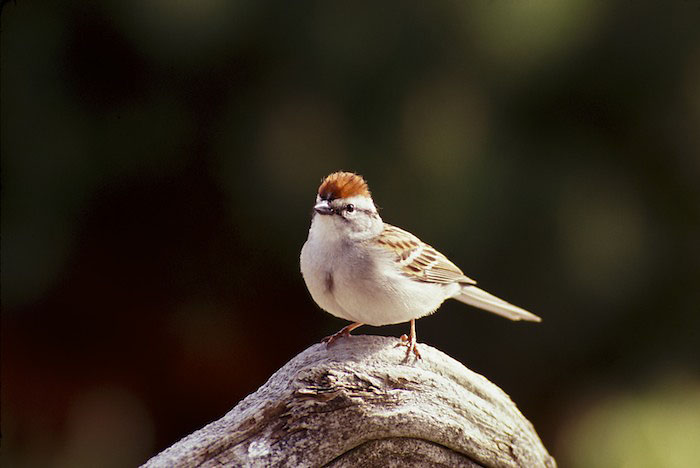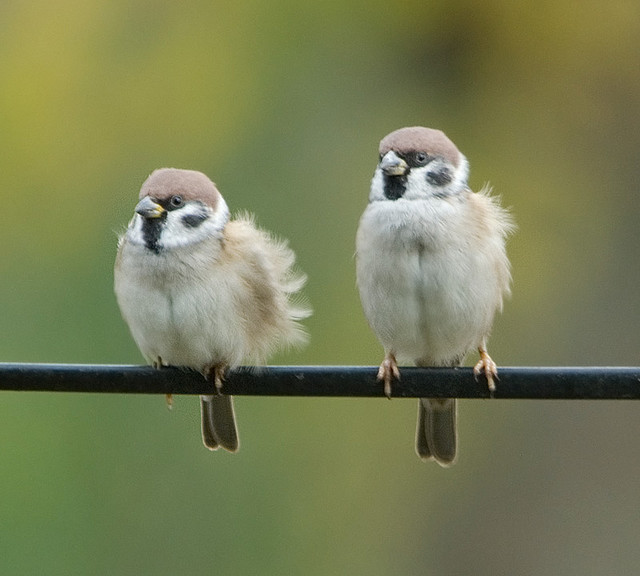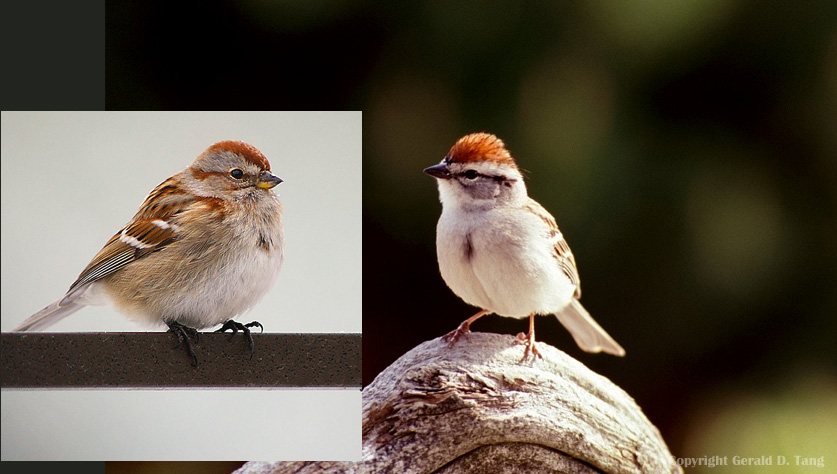Can you identify the sparrow shown in this photo? Read on for the discussion and answer below. Thanks to Jerry Tang for the photo and for bringing it to my attention. You can see more of his photos at http://tangsphoto.photoshelter.com

The dark central breast spot shown by some species of sparrows is a simple and reliable, maybe even foolproof, field mark. For example, American Tree Sparrows show a spot, Chipping Sparrows don’t.
Here is a sparrow with an obvious dark central spot on the breast, so it must be a Tree Sparrow, right? But you may notice some red flags: the black bill, thin blackish eyeline, pinkish legs, pale gray-white flanks, etc all look more like a Chipping Sparrow. What’s going on?!
The explanation is simple, and is a basic fact of the feather arrangements of all songbirds. The feathers that we call the breast (which really grow from the front of the neck) form a solid “shield” on the front of the body. Below that, what we call the belly feathers actually grow from the sides of the body inwards. The belly is unfeathered (an adaptation that allows incubating birds to part their feathers and put their skin in direct contact with the eggs for warmth) so it has to be covered by feathers growing from the sides. This forms a “seam” where feathers meet along the midline, and at any time of year it’s possible to see a slight crease along the center of the belly of any songbird.
Often there is an obvious dimple where the feathers from both sides meet at the lower edge of the breast. You can see it clearly in the two European Tree Sparrows below. In the case of the mystery sparrow above it’s a little more extreme, but I believe that the apparent dark breast spot shown by this sparrow is entirely the result of shadow, and this is a perfectly normal and typical Chipping Sparrow.

The dark breast spot of American Tree Sparrow is created by pigmented feathers (not shadow) so it will look a little different. It’s still a very useful clue to identification, but it’s always worth taking the extra time to double-check a few other features. Aside from the dark breast spot, things that distinguish Chipping from American Tree Sparrow are:
- uniform gray-white underparts on Chipping (vs. rusty smudge at shoulder and orange-brown flanks on Tree)
- legs pale pinkish (vs. legs blackish)
- blackish line through eye (vs rusty-brown on Tree)
- all black bill in summer, pinkish with dark culmen and tip in winter (vs. always bicolored black above and yellow below)
- less prominent wingbars
- eyebrow whitish, paler than cheeks (vs. eyebrow gray, about the same color as cheeks)
- smaller size with more delicate head and bill

References
Jerry Tang’s photos http://tangsphoto.photoshelter.com
Sergey Yeliseev’s Flickr photostream http://www.flickr.com/photos/yeliseev/with/2901875212/
Eric Bégin’s Flickr photostream http://www.flickr.com/photos/ericbegin/with/377147271/


Ah, yes, I’ve been fooled by this before. Thanks for indepth explanation!! ~karen
Yes, I’ve noticed these “feather dimples” before; they are most evident on plain-breasted birds, of cours. If you are able to watch the bird in question move, the “dimple” will change as the bird’s feathers move, and as the light changes. Also, might this area be slower to dry if the bird has been bathing or wetted? If so, it might look darker for a little while as it dries.
In a case such as the Chipping Sparrow photo above, the bird is so obviously a Chipping Sparrow that, seeing the “spot,” one would have to ask, “It’s probably not a spot. What else could cause that mark?”
Thanks for explaining so clearly how the arrangement of feathers creates the little dimple. Fascinating.
David — The dark central breast spot is due to more than simply shadow; most birds have dark down that can show through with the breast feathers held in a certain manner. I have shown a few birders this fact with birds in the hand; they’re always surprised.
Pingback: Do Black-chinned Sparrows Migrate? – Ploverbirds.com